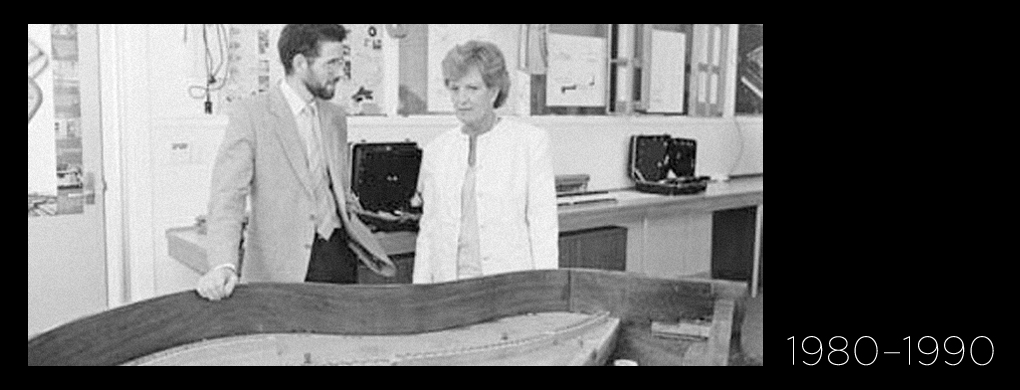The Keith Haring Mural - a Collingwood Technical College Treasure

The former Johnston Street site of Collingwood Technical College is home to a modern artistic treasure – a large public mural painted by legendary US street artist, Keith Haring.
The mural, painted in 1984 and located at 35 Johnston Street, Collingwood, is one of only 31 remaining public works by Haring known to be in existence. The subject of its preservation remains a contentious issue but day it was painted remains in the memory of many former Collingwood Tech students.
An artist influenced by Dr Seuss and Walt Disney
Keith Haring was an internationally acclaimed artist, who learned cartooning from his father and was influenced, as a child, by people such as Dr Seuss and Walt Disney. He initially studied commercial art but soon realised that he would not be happy in the world of commercial graphic art. He moved from Pittsburgh to New York City where he enrolled in the School of Visual Art. There he became involved in the vibrant alternative arts world in NY, where the arts community was working in public spaces such as alleyways, subways, downtown streets and disused halls.
He became friends with musicians, performing artists and graffiti artists and began to develop his distinctive style, which concentrated on the power and primacy of the line. Noticing the many unused advertising panels, covered with matte black paper, in the subways, Haring began to draw on these in white chalk, sometimes creating as many as forty ‘subway drawings ’ in one day. The subways became his workshops, where he could experiment with form and line and work out his ideas.
Haring achieves international recognition in the 1980’s
Between 1980 and 1989, Haring won international recognition and participated in numerous exhibitions around the world. He also opened a shop where his images were available to the public on a range of T-shirts, posters, buttons, toys and magnets. He was criticised by some artists for selling his work in this way, but as an artist, he remained committed to publicly accessible art and to art in public places. Haring worked with artists and performers as diverse as Madonna, Grace Jones, Timothy Leary, Yoko Ono and Andy Warhol.
Collingwood Technical College is given a treasure in 1984
On a visit to Australia in 1984, at the invitation of John Buckley, inaugural director of the Australian Centre for Contemporary Art, Haring painted an outdoor mural at the Collingwood Technical College. This mural is the only remaining public work from his three week visit here. Haring painted this in one day, watched by students and local residents. It features a giant worm with a computer monitor brain, above a group of dancing figures, resembling the chalk outlines of figures at a crime scene, and is typically bold and energetic in its use of line and colour.
Haring’s mural divides opinions in the art world
The mural has been registered as a site of state significance with the Victorian Heritage Council, but despite this listing, has deteriorated markedly, and faded to grey. In 1996, chemicals were applied to the mural to stabilise the wall and prevent further decay. Now the building has been earmarked as a home for Circus Oz and other organisations, and the future of the mural has to be decided.
There are several schools of thought by passionate admirers of Haring’s work. First, that it should be preserved as is, with something to seal the paintwork, leaving it in its faded state. This option is favoured by the Baillieu government and Arts Victoria. A second option is to preserve the work, but to also have it reproduced on another wall, as public art, in all its original strength and colour for the people of Australia, and returned to the people of Collingwood.
But the Executive Director of the Keith Haring Foundation, set up by the artist in 1991 before his death to be the authority on his work, has no doubt as to what needs to be done. Julia Gruen, who worked with Haring for six years, says the mural should be repainted:
‘Due to 27 years of neglect, the Collingwood mural is now a shadow of its former vibrant self...We believe it is more important that the work convey Keith’s ideals and respect for the communities in which he worked rather than preserve a brush stroke’.
Whatever is decided, it is important that the only public work in Australia by one of the 20th century’s great artists be given the care and respect it deserves.
A 1984 video of Keith Haring with Collingwood Technical School students and the finished mural can be viewed at https://vimeo.com/44861053 .
Sources:
‘Iconic Collingwood mural at art of debate’ Anna Whitelaw, Melbourne Times Weekly, 23 August, 2011.
‘Haring mural claims heritage status’ Melbourne Leader, 21/10/97.
Website ‘Save Melbourne’s Keith Haring mural, 2012’
www.haring.com/about_haring/bio/index.html Accessed February 22, 2012.